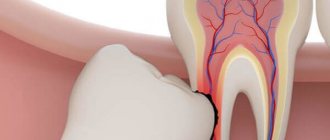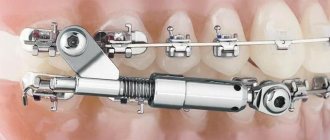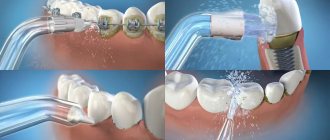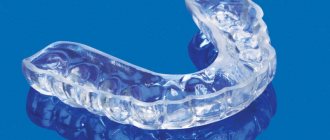Extracting the root of a badly damaged or broken tooth is one of the most time-consuming, painstaking and unpleasant dental procedures, requiring all the skill and knowledge of the surgeon. This is due to the fact that the roots of some teeth have a very complex anatomical structure, and their fragments can remain inside the gums. The dental surgeons at Dr. Granov’s clinic take their work very seriously and have extensive experience in successfully performing such operations. The root of a tooth may remain in the gum as a result of unsuccessful tooth extraction or injury. Usually in such cases, our patients are bothered by the sensation of a foreign object in the gum or pain in neighboring teeth. In addition, root fragments are clearly visible on an x-ray.
How a tooth root is removed in our clinic
A mandatory step in this procedure is the administration of local anesthesia. Typically, the pain relief lasts for several hours, and you will not experience any discomfort during the removal. After removal, a course of antibiotics is usually prescribed. As for the root removal process itself, the surgeon’s actions and the choice of instrument largely depend on the following circumstances:
- how deep is the root of the tooth;
- where the tooth is located: on the upper or lower jaw;
- are there pathological changes in the tissues around it, etc.
Removing a tooth root using forceps
First, the doctor separates the periodontal tissue from the root so that the exposed part of the root can be easily grabbed with forceps. If this is difficult to do, the doctor separates the periosteum and the edge of the mucosa from the socket. It is much more difficult to remove upper teeth than lower teeth, so bayonet-shaped and S-shaped forceps are used for this. The doctor places the instrument as tightly as possible and makes rotational movements with it. If the tissues surrounding the tooth are affected by an inflammatory process, then the problematic root can be extracted quite quickly. The most difficult teeth in this regard are the canines and lower molars, since they have large alveolar processes.
Reviews
Elevators are used in cases where extraction of a tooth or root for some reason (most often due to destruction of the coronal part) cannot be performed with forceps.
Despite the fact that this operation is considered more complex, the patient, thanks to anesthesia, in most cases does not experience any more discomfort than when removed with forceps.
If you had your teeth removed using an elevator, tell us what sensations this was accompanied by, were there any complications during wound healing? The comment form is located at the bottom of this page.
If you find an error, please select a piece of text and press Ctrl+Enter.
Tags: tooth extraction
Did you like the article? stay tuned
Previous article
Icone infiltration system or “liquid filling” for teeth
Next article
What is odontoma, how dangerous is it?
Tooth root removal using an elevator
In cases where the tooth root is located very deep and is difficult to reach with forceps, an elevator is used to remove it. The doctor inserts this instrument into the narrow gap between the edge of the hole and the root, and then rotates it while simultaneously pressing lightly. With these movements, the periodontal ligaments holding the root are torn. Using the elevator as a kind of lever, the doctor seems to push the root out of the hole. Even if it does not come out of the gum completely, the exposed part is enough to pull it out with forceps.
Important nuances when working with the tool
The success of elevators in root removal depends critically on the correct choice of tool and its proper use.
Before choosing a tool, a careful examination of the root and tooth to be removed is carried out. First of all, the strength of the crown is assessed, whether it can withstand the pressure of the forceps.
If there is reason to doubt this, select an elevator design that best suits the task ahead. To prevent the crown from interfering with work, it is bitten off.
Methods of using elevators depend on the severity of the bend of the roots being removed:
- If the curvature is insignificant , the root is deflected with the tool towards the curved side, applying the load in the direction of greatest compliance. This causes the socket to enlarge and the tooth to dislocate.
- If the roots of the 3rd molars are curved medially , the crown is sectioned, an elevator is inserted from the distal side, the crown is shifted distally and removed.
- If the medial and distal roots are bent in different directions , the tooth is divided into three parts, an elevator is inserted from the side opposite to the root being removed, and the distal and medial roots are shifted in the direction of the bend. After the periodontal ligaments have ruptured, the root is removed.
- When the root is bent in the lingual or buccal direction, the elevator expands the periodontal gap in the plane of the root bend and removes it.
- Premolars with a completely destroyed crown and a significant thickness of the alveolar process are removed by inserting cheek counters between adjacent teeth and the roots of the premolar.
- Direct elevators are advisable to use when removing wisdom teeth , especially if the clinical picture is accompanied by a problem with opening the mouth. The working part is located along the medial buccal surface of the figure eight.
Serious attention should be paid to sterilization of instruments. If disinfection is insufficient, transmission of infection is possible both from doctor to patient and from patient to doctor.
There is a certain method for sterilizing dental instruments, which involves performing several successive operations: soaking in an antiseptic solution, rinsing with running water, immersing in a biosol solution heated to 40°C, drying in the open air.
Easy Graft bone replacement material and its features.
In this publication we will tell you whether supernumerary teeth are always removed.
Here https://www.vash-dentist.ru/hirurgiya/udalenie-zubov/vse-tonkosti-lazernogo.html let’s take a closer look at the method of laser tooth removal.
The nuances of wisdom tooth root removal
In most cases, wisdom teeth are formed incorrectly and grow at an angle, so their roots are often located perpendicular to the roots of neighboring teeth and have a complex shape. Serious problems can arise even before the “eights” fully erupt. Removal of the roots of wisdom teeth occurs under regular x-ray control, especially if their coronal part is destroyed. Only a very experienced doctor can correctly extract the roots, otherwise irreparable harm can be caused to the roots of healthy neighboring teeth.
General overview
A dental elevator (lat. Elevator - lifting) is a hand-held dental instrument designed to remove dental roots and/or dystopic teeth by loosening and turning them out.
In terms of its action, the elevator is a classic lever and consists of 3 elements:
- working part (cheeks);
- pens;
- a long, narrow element connecting the cheek to the handle.
The cheek has the appearance of a convex-concave groove of oval, rectangular or spear-shaped. It can be symmetrical or asymmetrical, directed at different angles to the connecting part, with a mirror reflection or not.
A wide variety of shapes of the working part and its positions relative to the handle and connecting rod allows you to select an instrument that is optimally suited to perform the task facing the surgeon.
Elevators are made of chrome-nickel-molybdenum steel. Requirements for the composition and quality of the alloy are regulated by GOST 30208-94 (ISO 7153-1-88) and R 50328.1-92 (ISO 7153-1-88).
For the manufacture of elevators, steel grades B, C or D (20X13, 30X13, 45X14) are used. Tools made by powder metallurgy have the best quality. Fine steel powder containing alloying additives is pressed into a mold and sintered.
Is it necessary to remove tooth roots?
The issue of tooth root removal can only be decided by your attending dentist based on the examination and the X-ray obtained. If it is not a source of infection and the tissues surrounding it are healthy, then the root can be used in the future as a support for an artificial crown, having previously “extended” it using a stump tab. Tooth root extraction is highly recommended in the following situations:
- a cyst has formed on the root of the tooth;
- the tooth was severely damaged by caries;
- root fracture;
- one of the walls of the tooth has broken off, and the chip goes deep into the gums;
- There is severe tooth mobility caused by periodontal diseases.
Possible complications
Although complications from tooth extraction using an elevator are relatively rare, they are not only possible, but some of them can be quite serious.
Surgical dental practice notes the following complications when using elevators:
- Bleeding due to damage to large vessels.
- Damage or removal of the rudiments of permanent teeth when removing “milk jugs,” in particular, the follicle of wisdom teeth. This is facilitated by the interdental septum, which is elastic and adapts to the changeable bite.
- A puncture wound on the cheek of the tissue adjacent to the tooth being removed. The development of bleeding is dangerous if a large vessel has been damaged, for example, a branch of the carotid artery.
- Infection of a patient with a poorly sterilized elevator, development of alveolitis.
- Luxation (rupture of the periodontal ligament) of adjacent teeth due to improper use of the elevator.
- The tip of the instrument breaks off and gets stuck in the wound.
- Alveolar bone fracture. Can occur when removing buccal or medially curved roots - in cases where the load on the instrument is applied to the tips of the roots.
In dental practice, a curious case was recorded when, a month after successful tooth extraction, a granuloma formed in the area adjacent to it.
After its removal, a piece of the dental surgeon's nail was found in it, which was cut off with an elevator during root removal.
The video provides additional information on the topic of the article.
The most frequently asked questions from our patients
What happens if the tooth root is left in the gum?
If the root of the tooth is left as is, it becomes a source of infection, and after some time serious complications may develop, for example:
- inflammation of the tissues surrounding the tooth, including bone;
- penetration of infection into the wound surface;
- periodontal disease.
What is a root canal and can it be treated rather than removed?
The root (or dental) canal is an anatomical space inside the root of a tooth filled with pulp. Cleaning and treatment of dental canals is a mandatory stage of dental fillings and prosthetics. In our clinic, for this purpose, we use self-adapting files of the SAF system, which carefully clean the canals from dead and diseased tissue, pus, and accumulations of bacteria, without injuring healthy areas of the tooth. Thanks to their hollow structure, the doctor can simultaneously treat the root canal with disinfectants and anti-inflammatory drugs. Root canals are preserved only if the tissues surrounding the tooth are not affected by pathological processes, and in the future the root can be used for prosthetics.
If the tooth can still be restored, root canal treatment (roots) of the tooth is performed. It can be successfully completed in our Moscow clinic.
Types and purpose
Depending on the shape of the cheek and its position relative to the connecting part, the following main types of instruments are distinguished:
- straight;
- bayonet-shaped;
- angular.
The bayonet-shaped design is a subtype of the straight one. In addition to the above types, there are also special tools designed to perform more specific tasks , in particular, elevators for removing individual root fragments, wisdom teeth, etc.
Many instruments belonging to one of the above groups bear the name of their developer - Lecluse, Vint, Barry, Pott.
For what purpose is the wound filled with alvostasis with a sponge after tooth extraction and what effect does the drug have?
Come here to find out in what cases socket suturing is performed after tooth extraction.
At this address https://www.vash-dentist.ru/hirurgiya/udalenie-zubov/stomatologicheskogo-shovnogo-materiala.html you will find an overview of suture material for dental surgery.
Straight
The working and intermediate parts of a straight elevator are located in a straight line. The cheeks can be rectangular, oval or bayonet-shaped. Their edges are usually thinned and pointed. Some have notches that increase the adhesion strength to the root being removed.
Direct elevators are used primarily for removing dental roots and dystopic teeth, including maxillary 3rd molars.
The most famous straight design was developed by Lecluse, and bears his name. The most notable features of the Lecluse elevator are the handle, attached at right angles to the connecting part, and the bayonet-shaped cheek.
In appearance, Lecluse's instrument resembles a corkscrew. Due to its considerable length and power, it is used for extraction of lower “eights”.
Angular
The peculiarity of the corner elevator is that the spoon bends in relation to the connecting part at an angle of approximately 120 °C. This makes it convenient to create leverage on the roots of teeth in various directions.
The bend can be with a right or left turn (“away from yourself” or “towards you”). The spoon may be jagged and its shape is usually oval or spear-shaped.
The corner elevator is most often used to remove individual roots and dystopic teeth. In this case, the convex part rests against the wall of the hole, and the concave part is directed towards the root to be removed.
Angular tools include Winter, Barry, and Pott elevators. All of them have a handle located perpendicular to the connecting part. These are powerful tools that allow effective luxation (Latin luxatio - displacement, dislocation) of the root and subsequent removal.
Bayonet-shaped
The bayonet elevator is a straight elevator. Its cheek is shaped like the tip of a spear, one side is smooth, the other is convex.
An example of using a bayonet-shaped instrument: with a completely destroyed crown of the 1st molar and a thick interradicular septum, it is used to separate the roots and dislocate and remove them separately.
The Lecluse elevator, which also belongs to the bayonet type, is used to remove third molars on the lower jaw. Its length and power are quite sufficient for this task.
However, you need to act carefully, since there is a danger of dislocation of the neighboring teeth on which the instrument rests.
To remove root fragments
To remove separated roots or fragments thereof, it is convenient to use instruments with very thin cheeks, sometimes located on both sides of the instrument and in different directions to each other (“away from you” and “towards you”). The surgeon holds such an instrument in the “writing pen” manner.










